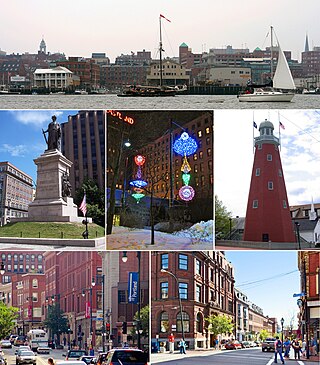
Portland is the most populous city in the U.S. state of Maine and the seat of Cumberland County. Portland's population was 68,408 in April 2020. The Greater Portland metropolitan area has a population of approximately 550,000 people. Historically tied to commercial shipping, the marine economy, and light industry, Portland's economy in the 21st century relies mostly on the service sector. The Port of Portland is the second-largest tonnage seaport in the New England area as of 2019.

Windham is a town in Cumberland County, Maine, United States. The population was 18,434 at the 2020 census. It includes the villages of South Windham and North Windham. It is part of the Portland–South Portland–Biddeford, Maine Metropolitan Statistical Area.

The University of Southern Maine (USM) is a public university with campuses in Portland, Gorham and Lewiston in the U.S. state of Maine. It is the southernmost of the University of Maine System. It was founded as two separate state universities, Gorham Normal School and Portland University. The two universities, later known as Gorham State College and the University of Maine at Portland, were combined in 1970 to help streamline the public university system in Maine and eventually expanded by adding the Lewiston campus in 1988.

The Androscoggin River is a river in the U.S. states of Maine and New Hampshire, in northern New England. It is 178 miles (286 km) long and joins the Kennebec River at Merrymeeting Bay in Maine before its water empties into the Gulf of Maine on the Atlantic Ocean. Its drainage basin is 3,530 square miles (9,100 km2) in area. The name "Androscoggin" comes from the Eastern Abenaki term Ammoscongon, which referred to the entire portion of the river north of the Great Falls in Lewiston, Maine. The Anglicization of the Abenaki term is likely an analogical contamination with the colonial governor Edmund Andros.

Exchange Street is a main commercial thoroughfare in the Old Port of Portland, Maine, United States. Originally laid out in 1724, today it features a number of designer clothing stores, as well as several small, locally owned businesses, including Sherman's Maine Coast Books. It runs, one-way, for around 0.24 miles (0.39 km), from Congress Street in the northwest to Fore Street in the southeast. Its main intersections are with Congress Street, Federal Street, Middle Street and Fore Street.
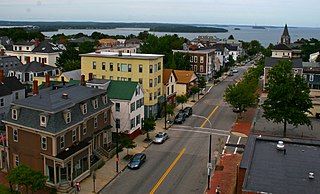
Munjoy Hill is a neighborhood and prominent geographical feature of Portland, Maine. It is located east of downtown and south of East Deering, the neighborhood via Tukey's Bridge. In the nineteenth and twentieth centuries, the neighborhood had a large Irish and Italian American population.

The Presumpscot River is a 25.8-mile-long (41.5 km) river located in Cumberland County, Maine, United States. It is the main outlet of Sebago Lake. The river provided an early transportation corridor with reliable water power for industrial development of the city of Westbrook and the village of South Windham.
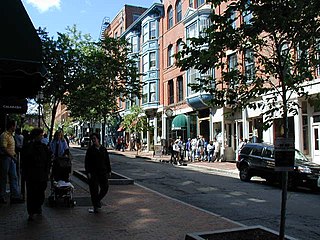
The Old Port is a district of Portland, Maine, known for its cobblestone streets, 19th-century brick buildings and fishing piers. The district contains boutiques, restaurants and bars.
Portland, Maine, is home to many neighborhoods.
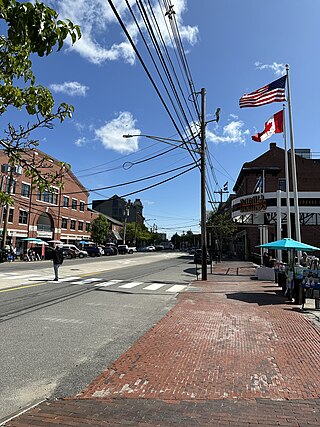
Commercial Street is a downtown street in the Old Port of Portland, Maine, United States. It is part of U.S. Route 1A. It became the Old Port's waterfront in the early 20th century, replacing Fore Street, after land was reclaimed from the waters of Casco Bay and the Fore River.

Franklin Street is a four-lane street in Portland, Maine, United States. It is a major corridor for traffic from Interstate 295 to Portland's downtown, Old Port, and to other neighborhoods located on the Portland peninsula. Part of U.S. Route 1A, it is around 0.77 miles (1.24 km) long, running between Marginal Way in the northwest and Commercial Street in the southeast.
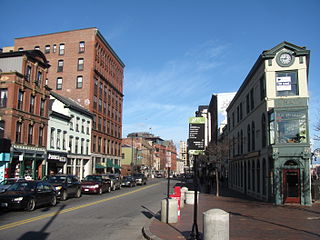
Congress Street is the main street in Portland, Maine. Around 5.77 miles (9.29 km) long, it stretches from County Road, Portland's southwestern border with Westbrook, through a number of neighborhoods, before ending overlooking the Eastern Promenade on Munjoy Hill. In March 2009, the Portland City Council designated much of the inner portion of Congress Street a historic district. The western section of the street includes the city's Arts District.
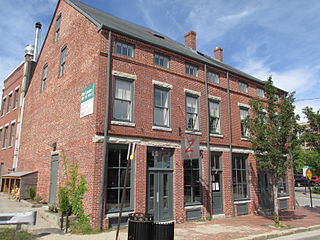
The Tracy-Causer Block is a historic commercial building located at 505-509 Fore Street in the Old Port commercial district of Portland, Maine. Built in 1866 as a mixed-used residential and commercial building, it is a rare surviving example of this type of building in the city. It was listed on the National Register of Historic Places in 1994.

Yarmouth is a town in Cumberland County, Maine, United States, twelve miles north of the state's largest city, Portland. When originally settled in 1636, as North Yarmouth, it was part of the Massachusetts Bay Colony, and remained part of its subsequent incarnations for 213 years. In 1849, twenty-nine years after Maine's admittance to the Union as the twenty-third state, it was incorporated as the Town of Yarmouth.

Forest Avenue is a major street in Portland, Maine, United States. It runs for around 4.78 miles (7.69 km), from Bridgton Road in the northwest to Congress Street, in downtown Portland, in the southeast. It is the main artery for traffic entering and leaving Portland to and from the west via city streets. Forest Avenue passes to the south of Back Cove, while Washington Avenue passes to its north. The street ends in Portland's Arts District.

Fore Street is a downtown street in Portland, Maine, United States. Dating to 1724, it runs for around 1 mile (1.6 km), from the Eastern Promenade on Munjoy Hill in the northeast to Pleasant Street in the southwest. Near its midsection, Fore Street crosses Franklin Street. It splits briefly at Boothby Square, shortly after passing the United States Custom House. The street passes through the Old Port district.

Middle Street is a downtown street in Portland, Maine, United States. Dating to 1724, it runs for around 0.46 miles (0.74 km), from an intersection with Union Street, Spring Street and Temple Street in the southwest, to Hancock Street, at the foot of Munjoy Hill, in the northeast. It formerly originated at what was then known as Market Square, but 20th-century redevelopment saw the section between Monument Square and Free Street pedestrianized, and the remaining section—around The Maine Lobsterman monument on Temple Street—erased.

India Street is a downtown street and neighborhood in Portland, Maine, United States. Situated near the western foot of Munjoy Hill, it runs for around 0.28 miles (0.45 km), from Congress Street in the northwest to Commercial Street and Thames Street in the southeast. It was the city's first street, and the location of the first settlement of European immigrants to the city in the 17th century. There are thirty handmade bricks in the sidewalk commemorating the neighborhood's notable events. In 1680, when Thomas Danforth was Deputy Governor of the Massachusetts Bay Colony, the street was known as Broad Street. After the incorporation of the Town of Falmouth in 1718, the street was known as High King Street.

Portland station was a passenger rail station on the Grand Trunk Railway in Portland, Maine, United States. It stood to at the foot of India Street, Portland's first street, between 1903 and 1966. It was one of Portland's four railroad stations for the Portland and Forest Avenue Railroad Company over its history, and one of the two stations in the city at the time of the station's construction. The other was Union Station, which has also been demolished.

Portland Water District (PWD) is a publicly-owned water company based Portland, Maine, United States. It was established, as Portland Water Company (PWC), in 1862 by a group of Portland citizens as a private company as a means to ensure continued growth. The wells which had been used up to that point were proving inadequate. Its water is sourced from Sebago Lake, Maine's second-largest lake, as it has been since 1869.




















